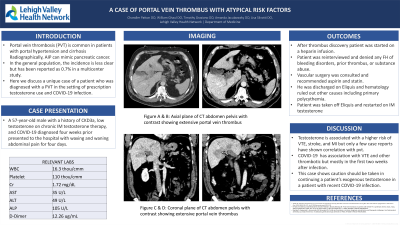Sunday Poster Session
Category: Liver
P1151 - A Case of Portal Vein Thrombus With Atypical Risk Factors
Sunday, October 22, 2023
3:30 PM - 7:00 PM PT
Location: Exhibit Hall

Has Audio
- CP
Chandler Patton, DO
Lehigh Valley Health Network
Allentown, PA
Presenting Author(s)
Chandler Patton, DO, William Ghaul, DO, Timothy Graziano, DO, Amanda Jacubowsky, DO, Lisa Silvotti, DO
Lehigh Valley Health Network, Allentown, PA
Introduction: Portal vein thrombosis (PVT) is common in patients with portal hypertension and cirrhosis with some studies showing a prevalence of 0.6 - 15.8%. In the general population, the incidence is less clear but has been reported as 0.7% in a multicenter study. Here we discuss a unique case of a patient who was diagnosed with a PVT in the setting of prescription testosterone use and COVID-19 infection.
Case Description/Methods: A 57-year-old male with a history of CKD3a, low testosterone on chronic IM testosterone therapy, and COVID-19 diagnosed four weeks prior presented to the hospital with waxing and waning abdominal pain for four days. On arrival, he was hemodynamically stable and his initial laboratory workup was significant for thrombocytopenia and a d-dimer of 12 mg/L FEU. A CT abdomen and pelvis showed extensive portal and mesenteric venous thrombosis throughout the intra and extrahepatic venous system and small bowel mesentery. On a secondary interview, he denied any personal or family history of blood clotting disorders, recent travel, surgeries, alcohol use, drug use, tobacco use, and no known history of malignancy. The patient was then started on a heparin infusion and was evaluated by vascular surgery who recommended initiation of aspirin and statin. The patient remained stable and was ultimately transitioned from heparin to Eliquis with plans for discharge and hematology follow-up. As an outpatient, hematology excluded primary polycythemia and ultimately stopped the patient's Eilquis with plans to later trial him back on IM testosterone.
Discussion: This case demonstrates a patient without classic risk factors for portal veinous thrombus like cirrhosis or hypercoagulable disorders. Instead, his diagnosis was in the setting of two rare but potential causes of portal vein thrombus. Testosterone is associated with a higher risk of VTE, stroke, and MI but with regard to PVT, only a few case reports have ever correlated the two. COVID-19 has stronger data to support its association with VTE and other thrombotic events with most thrombotic events happening in the first two weeks after infection. Similarly, for COVID-19 there are a few small studies and case reports linking COVID-19 specifically with PVT. Given the lack of other significant risk factors, it is possible that the two entities of COVID-19 infection and testosterone combined caused this acute case of PVT. This case shows caution should be taken in continuing a patient’s exogenous testosterone a patient with recent COVID-19 infection.
Disclosures:
Chandler Patton, DO, William Ghaul, DO, Timothy Graziano, DO, Amanda Jacubowsky, DO, Lisa Silvotti, DO. P1151 - A Case of Portal Vein Thrombus With Atypical Risk Factors, ACG 2023 Annual Scientific Meeting Abstracts. Vancouver, BC, Canada: American College of Gastroenterology.
Lehigh Valley Health Network, Allentown, PA
Introduction: Portal vein thrombosis (PVT) is common in patients with portal hypertension and cirrhosis with some studies showing a prevalence of 0.6 - 15.8%. In the general population, the incidence is less clear but has been reported as 0.7% in a multicenter study. Here we discuss a unique case of a patient who was diagnosed with a PVT in the setting of prescription testosterone use and COVID-19 infection.
Case Description/Methods: A 57-year-old male with a history of CKD3a, low testosterone on chronic IM testosterone therapy, and COVID-19 diagnosed four weeks prior presented to the hospital with waxing and waning abdominal pain for four days. On arrival, he was hemodynamically stable and his initial laboratory workup was significant for thrombocytopenia and a d-dimer of 12 mg/L FEU. A CT abdomen and pelvis showed extensive portal and mesenteric venous thrombosis throughout the intra and extrahepatic venous system and small bowel mesentery. On a secondary interview, he denied any personal or family history of blood clotting disorders, recent travel, surgeries, alcohol use, drug use, tobacco use, and no known history of malignancy. The patient was then started on a heparin infusion and was evaluated by vascular surgery who recommended initiation of aspirin and statin. The patient remained stable and was ultimately transitioned from heparin to Eliquis with plans for discharge and hematology follow-up. As an outpatient, hematology excluded primary polycythemia and ultimately stopped the patient's Eilquis with plans to later trial him back on IM testosterone.
Discussion: This case demonstrates a patient without classic risk factors for portal veinous thrombus like cirrhosis or hypercoagulable disorders. Instead, his diagnosis was in the setting of two rare but potential causes of portal vein thrombus. Testosterone is associated with a higher risk of VTE, stroke, and MI but with regard to PVT, only a few case reports have ever correlated the two. COVID-19 has stronger data to support its association with VTE and other thrombotic events with most thrombotic events happening in the first two weeks after infection. Similarly, for COVID-19 there are a few small studies and case reports linking COVID-19 specifically with PVT. Given the lack of other significant risk factors, it is possible that the two entities of COVID-19 infection and testosterone combined caused this acute case of PVT. This case shows caution should be taken in continuing a patient’s exogenous testosterone a patient with recent COVID-19 infection.
Disclosures:
Chandler Patton indicated no relevant financial relationships.
William Ghaul indicated no relevant financial relationships.
Timothy Graziano indicated no relevant financial relationships.
Amanda Jacubowsky indicated no relevant financial relationships.
Lisa Silvotti indicated no relevant financial relationships.
Chandler Patton, DO, William Ghaul, DO, Timothy Graziano, DO, Amanda Jacubowsky, DO, Lisa Silvotti, DO. P1151 - A Case of Portal Vein Thrombus With Atypical Risk Factors, ACG 2023 Annual Scientific Meeting Abstracts. Vancouver, BC, Canada: American College of Gastroenterology.
